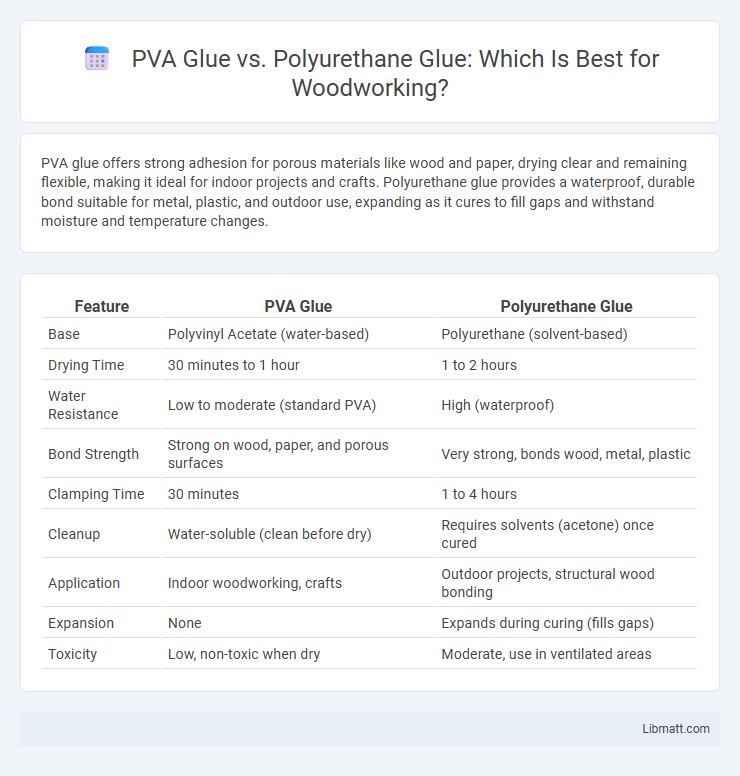PVA glue offers strong adhesion for porous materials like wood and paper, drying clear and remaining flexible, making it ideal for indoor projects and crafts. Polyurethane glue provides a waterproof, durable bond suitable for metal, plastic, and outdoor use, expanding as it cures to fill gaps and withstand moisture and temperature changes.
Table of Comparison
| Feature | PVA Glue | Polyurethane Glue |
|---|---|---|
| Base | Polyvinyl Acetate (water-based) | Polyurethane (solvent-based) |
| Drying Time | 30 minutes to 1 hour | 1 to 2 hours |
| Water Resistance | Low to moderate (standard PVA) | High (waterproof) |
| Bond Strength | Strong on wood, paper, and porous surfaces | Very strong, bonds wood, metal, plastic |
| Clamping Time | 30 minutes | 1 to 4 hours |
| Cleanup | Water-soluble (clean before dry) | Requires solvents (acetone) once cured |
| Application | Indoor woodworking, crafts | Outdoor projects, structural wood bonding |
| Expansion | None | Expands during curing (fills gaps) |
| Toxicity | Low, non-toxic when dry | Moderate, use in ventilated areas |
Introduction: Understanding PVA and Polyurethane Glue
PVA glue, known for its water-based formula, excels in woodworking and paper projects due to its fast drying time and ease of cleanup. Polyurethane glue offers superior strength and moisture resistance, making it ideal for outdoor and heavy-duty applications where durability is critical. Choosing the right adhesive depends on your project's material requirements and environmental exposure.
Composition and Chemical Properties
PVA glue is primarily composed of polyvinyl acetate, a water-based adhesive that forms strong bonds through polymerization, making it ideal for porous materials like wood and paper. Polyurethane glue, in contrast, contains isocyanate compounds that react with moisture to expand and create durable, waterproof bonds suitable for non-porous surfaces and outdoor applications. Understanding these chemical properties helps you choose the right adhesive for your project's specific material and environmental conditions.
Key Differences Between PVA and Polyurethane Glue
PVA glue is water-based, dries clear, and works best on porous materials like wood and paper, offering easy cleanup and moderate water resistance. Polyurethane glue is moisture-curing, expands as it dries to fill gaps, and provides superior strength and waterproofing for diverse substrates including metal, plastic, and ceramics. Understanding these key differences helps you select the right adhesive for durability, bonding strength, and environmental conditions.
Bonding Strength and Durability
PVA glue offers strong initial adhesion but is less resistant to moisture and temperature fluctuations, which can weaken its bonding over time. Polyurethane glue creates an exceptionally strong, waterproof bond that withstands extreme environmental conditions and provides superior durability for wood, metal, and plastic materials. For long-lasting projects exposed to moisture or stress, polyurethane glue is generally the better choice due to its expansion properties and chemical curing process.
Suitability for Different Materials
PVA glue works best for porous materials like paper, wood, and fabric, offering strong bonds for woodworking and crafts. Polyurethane glue excels with a wider range of materials, including metal, plastic, ceramic, and even wet or outdoor surfaces, due to its expanding and waterproof properties. Understanding your project's material needs ensures you choose the right adhesive for lasting durability and optimal results.
Water Resistance and Moisture Tolerance
Polyurethane glue exhibits superior water resistance and moisture tolerance compared to PVA glue, making it ideal for outdoor and high-humidity applications. PVA glue tends to break down when exposed to water or excessive moisture, limiting its use to indoor projects or dry conditions. Polyurethane glue's ability to expand and cure in the presence of moisture enhances its bond strength on wet or porous surfaces.
Drying and Curing Times
PVA glue typically dries to the touch within 30 minutes and fully cures in 24 hours, making it suitable for projects requiring quick handling. Polyurethane glue has a slower drying time, often taking 1 to 2 hours to set and up to 24 to 48 hours to fully cure, especially in less humid conditions. Moisture accelerates polyurethane curing, whereas PVA glue relies on evaporation and absorbs into wood fibers for bonding.
Safety, Odor, and Environmental Impact
PVA glue is generally safer for indoor use due to its low toxicity and minimal odor, making it suitable for schools and homes. Polyurethane glue emits stronger fumes and requires proper ventilation during application, posing higher respiratory risks. Environmentally, PVA glue is water-based and biodegradable, whereas polyurethane glue contains chemicals that are less eco-friendly and can take longer to break down in the environment.
Cost and Availability Comparison
PVA glue is generally more affordable and widely available in most hardware stores, making it a cost-effective option for everyday woodworking and paper projects. Polyurethane glue tends to be more expensive due to its specialized bonding properties and may require purchase from specialty retailers or online stores. If budget and easy access matter most to You, PVA glue offers a convenient and economical choice.
Choosing the Right Glue for Your Project
PVA glue provides excellent adhesion for porous materials like wood, paper, and fabric, making it ideal for indoor woodworking and general crafts due to its easy application and quick drying time. Polyurethane glue offers superior strength and water resistance, bonding non-porous surfaces such as metal, plastic, and stone, which suits outdoor furniture, repairs, and projects exposed to moisture. Selecting the right adhesive depends on materials involved, environmental conditions, and the required bond durability to ensure optimal performance and longevity of your project.
PVA glue vs polyurethane glue Infographic

 libmatt.com
libmatt.com